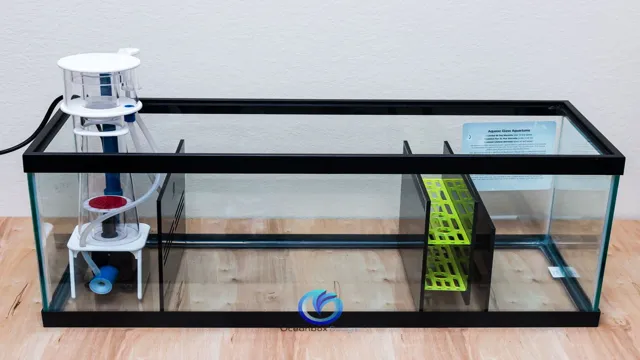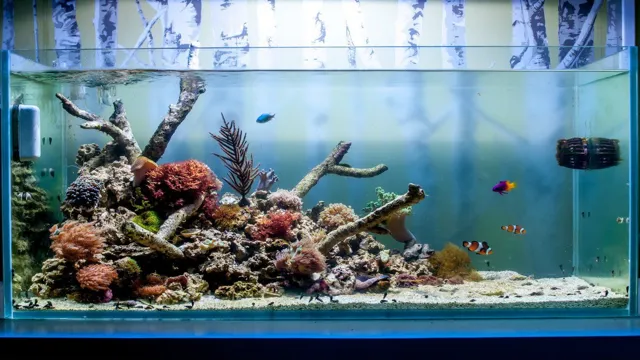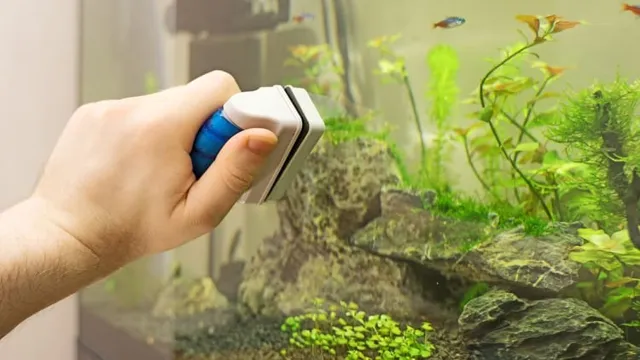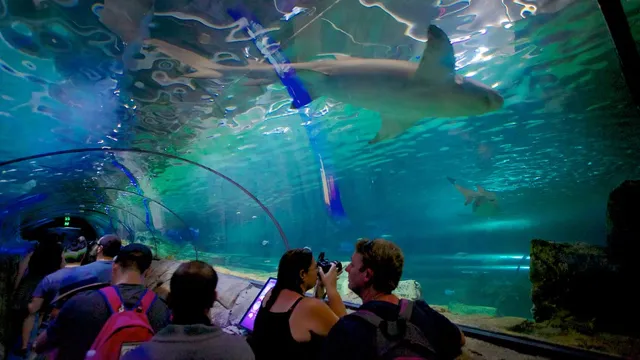Aquariums have become a popular fixture in many households, providing a unique perspective on aquatic life that is often difficult to obtain in the outdoors. But the origins of these fascinating tanks date back much further than one might imagine. In fact, the discovery of aquariums can be traced back thousands of years to ancient civilizations such as the Egyptians and the Romans.
These early aquariums were simple and primarily served as a means of displaying aquatic plants. However, as time progressed, individuals began experimenting with ways to keep fish and other aquatic creatures in captivity. With the advent of new technologies and advancements in science, the modern aquarium as we know it today was born.
This fascinating journey from ancient times to the present day is an intriguing tale that continues to captivate aquarium enthusiasts around the world. So, join me on this journey as we explore the discovery of aquariums and how they came to be one of the most beloved fixtures in the modern home.
Aquarium History
Aquariums have been around for quite some time, but who exactly invented them? The credit actually goes to the ancient Romans, who were known to keep sea creatures in glass vessels for entertainment. However, it wasn’t until the 1800s that the modern aquarium was invented. In 1853, an Englishman named Philip Henry Gosse created the first fully functioning aquarium, complete with specialized lighting and temperature controls.
His invention sparked a trend, and soon aquariums became a popular household feature. Today, aquariums are not only used for entertainment, but also for scientific research and education. It’s amazing to think that such a simple invention from over a century ago has had such a lasting impact on our lives today.
Ancient Fish-Keeping in Rome
Aquarium History While many of us might consider aquariums a modern invention, the ancient Romans actually had their own version of fish-keeping! Known as “piscinae”, these were ornamental ponds and pools that were often filled with exotic fish and used as status symbols by wealthy homeowners. These fish were highly prized and even had personal attendants to care for them. While the piscinae were primarily used for aesthetic purposes, they did serve some functional roles as well.
For example, some piscinae were used as a source of fresh fish for local markets and restaurants. Today, we continue the tradition of fish-keeping with modern aquariums, which come in a variety of shapes, sizes, and technologies. Whether you prefer a small bowl with a single betta fish or a giant tank with a school of vibrant tropical fish, aquariums remain a popular way to bring a little bit of the natural world into our homes and offices.
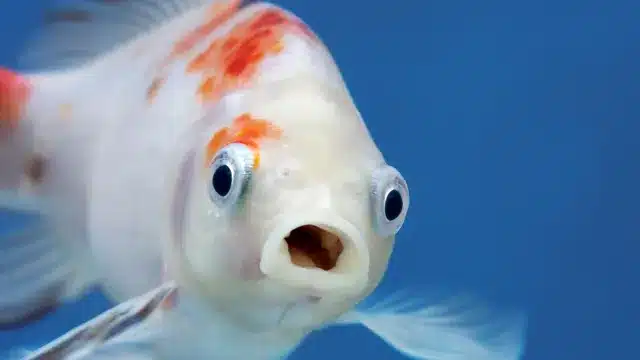
Aquarium Transformation in the Renaissance
Aquariums have been around since ancient times as a way to display aquatic life, but it wasn’t until the Renaissance that aquariums began to transform into mesmerizing works of art. Royals and nobles would create these elaborate aquariums to showcase exotic species, and they became a status symbol. These aquariums were typically made of glass or crystal and filled with seawater and colorful fish.
The fish were seen as living jewels, and the aquariums were often placed in luxurious rooms, adding to the overall opulence of the space. The transformation of aquariums during the Renaissance played a significant role in popularizing them as a form of entertainment, and they continue to be a beloved hobby to this day.
Birth of Modern Aquariums in 1850s
Aquariums have come a long way since their humble beginnings in the ancient world. However, it wasn’t until the mid-19th century that modern aquariums as we know them today were born. In the early 1850s, the first glass aquariums were invented by Jeanne Villepreux-Power, a French naturalist, and inventor.
She used her invention to study marine life in their natural habitats and created the first successful aquarium for public viewing. Over time, aquariums became increasingly popular, and people began to experiment with different sizes and shapes to create the perfect environment for their fish. The development of modern filtration systems and innovative technology has also allowed aquarium enthusiasts to recreate the complex ecosystems present in real-life aquatic environments.
Today, aquariums are a popular pastime enjoyed by hobbyists and professionals alike, and they continue to be a vital part of marine conservation and research. With so much history and innovation behind them, aquariums will undoubtedly continue to play an essential role in our understanding and appreciation of marine life. (See Also: How to Afford Monterrey Aquarium: Budget-Friendly Tips and Tricks)
Aquarium Innovators
Aquariums have become a popular household item today, but have you ever wondered about the innovators behind them? It is believed that the ancient Romans were the pioneers in glass-making techniques and the first to keep fish in containers, but modern-day aquariums were inspired by Jeanne Villepreux-Power, a French marine biologist in the 19th century. She created the first functional glass aquarium in 1832 to study cuttlefish. Later on, writer Philip Henry Gosse developed the modern aquarium with a self-contained ecosystem.
His “Aquarium: An Unveiling of the Wonders of the Deep Sea” detailed the operation and maintenance of aquariums and helped popularize them in Victorian England. Today, aquariums have undergone several innovative transformations, thanks to advancements in technology, materials, and design. They are now a popular hobby enjoyed by millions worldwide and can be found in homes, offices, and public places.
Jeanne Villepreux-Power
Jeanne Villepreux-Power was a French naturalist and inventor who made significant contributions to the world of marine biology. One of her most notable innovations was the invention of the aquarium, which she designed and created herself in 183 Villepreux-Power was inspired to create an aquarium after observing the behavior of a squid in its natural habitat.
She noticed that the squid would release ink as a defense mechanism when threatened, and she wanted to observe this behavior more closely. However, at the time, there was no way to observe marine life up close without removing it from its natural habitat. This was not only harmful to the organisms but also made it difficult to observe their behavior accurately.
Villepreux-Power’s aquarium invention revolutionized the study of marine biology by allowing scientists to study marine life up close while preserving their natural environment. Her innovation paved the way for future advancements in the field and is still in use today.
Robert Warrington
Aquarium Innovators, Robert Warrington Robert Warrington is a renowned name in the world of aquariums, known for his innovative and eco-friendly designs. His love for aquatic life and his passion for sustainability has led him to create unique setups that blend perfectly with nature. Warrington has been in the aquarium industry for over 30 years, starting as a hobbyist and then transitioning to a professional career.
His experience in aquascaping and marine biology has allowed him to develop techniques that enhance the living conditions for the fish and other aquatic creatures. One of his most significant contributions to the industry is the creation of self-sustaining ecosystems, which use natural filtration systems instead of traditional mechanical ones. These setups not only look stunning but also reduce the burden on the environment.
Warrington’s work has inspired many aquarium enthusiasts to think beyond the traditional setup and embrace sustainability. His influence in the industry is undeniable, and his work continues to inspire the next generation of aquarium innovators.
Gosse and His ‘Aquarium’
Gosse was one of the earliest innovators in the world of aquariums. In fact, he is credited with inventing the modern aquarium as we know it today. Gosse’s fascination with marine life led him to create a glass-sided tank that allowed him to observe and study the behavior of sea creatures in their natural habitat.
His book, “The Aquarium: An Unveiling of the Wonders of the Deep Sea,” was a huge success and helped to popularize the hobby of keeping fish in captivity. Today, aquariums are found all over the world, ranging from small home setups to massive public displays. Thanks to pioneers like Gosse, we can enjoy the beauty and diversity of marine life without ever leaving our homes. (See Also: Is London Aquarium Worth it? An In-Depth Review)
Contemporary Aquariums
Aquariums have come a long way from what they used to be. From being merely a holding place for aquatic creatures, contemporary aquariums have become a staple in interior design and an art form in themselves. But have you ever wondered who invented aquariums? The concept of aquariums dates back to ancient Rome, where the wealthy kept fish in marble and glass tubs.
However, the modern aquarium as we know it today was invented in the mid-19th century by a man named Jeanne Villepreux-Power. She was a French marine biologist who was fascinated by the behavior of cephalopods and wanted to study them closely in a controlled environment. She designed a glass cage with a water supply system that allowed her to study and observe the creatures in their natural habitat.
Her invention quickly caught on, and soon, aquariums were being used for both scientific research and display purposes. Today, aquariums are not only a source of entertainment and education but also serve as a reminder of our relationship with the underwater world.
Public Aquariums
Public aquariums have come a long way over the years, evolving from just a place to see some fish to a full-fledged experience for visitors. Contemporary aquarium designs boast innovative and sustainable technologies that not only provide an interactive and educational platform but also prioritize the well-being of their marine creatures. These state-of-the-art aquariums focus on providing an immersive experience where visitors can learn about marine life, conservation, and the environment.
They use multimedia displays, interactive exhibits, and virtual reality to create experiences that mimic oceanic environments. These aquariums also prioritize conservation by recognizing and addressing the impact humans have on the ocean and its inhabitants. By using modern technology, they provide a platform to raise awareness and educate the public on critical environmental issues.
It’s a step towards a brighter and sustainable future for the ocean, where we can come together and protect our marine ecosystem.
Residential Aquariums
If you are looking for a way to bring a unique and contemporary feel to your home, consider investing in a residential aquarium. Aquariums are a fantastic way to add an eye-catching feature to your living space, and modern designs offer a fresh take on the traditional fish tank. Contemporary aquariums come in a variety of shapes and sizes, with options ranging from sleek cylinder tanks to custom installations that flow seamlessly with your decor.
Not only do they offer aesthetic appeal, but aquariums can have health benefits as well. Studies have shown that watching fish swim can have a calming effect, reducing stress and anxiety levels in those who observe them. Plus, taking care of fish can be a rewarding hobby for all ages.
With so many options available, a contemporary aquarium may just be the perfect addition to your home.
Conclusion
In conclusion, it is difficult to pinpoint a single inventor of aquariums. While the ancient Sumerians and Egyptians dabbled in fishkeeping, it was not until the Victorian era that the modern aquarium as we know it began to take shape. However, we must also give credit to the marine biologists, engineers, and hobbyists who have continued to innovate and improve upon the aquarium over the years.
So the true inventor of the aquarium? It seems that credit is due to a collaborative effort spanning centuries and countless creative minds. As they say, it takes a village to raise a fish tank.” (See Also: How to Make Aquarium Silicone Dry Faster: Tips and Tricks for Quick Drying)
FAQs
What is an aquarium?
An aquarium is a transparent container filled with water used for keeping fish and other aquatic creatures.
When were aquariums first created?
Aquariums were first created during the Roman era, where wealthy families would keep fish in ornamental ponds.
Who invented the modern aquarium?
The modern aquarium was invented by Jeanne Villepreux-Power, a French biologist who created the first glass aquarium in the 1830s.
What is the purpose of an aquarium?
The purpose of an aquarium is to provide a habitat for fish and other aquatic creatures, while also providing entertainment and educational value to humans.
What are some common types of fish kept in aquariums?
Some common types of fish kept in aquariums include goldfish, angelfish, guppies, and betta fish.
What are some common materials used to build aquariums?
Some common materials used to build aquariums include glass, acrylic, and plastic.
How do you maintain a healthy aquarium for fish?
To maintain a healthy aquarium for fish, you need to regularly clean the tank, monitor the water temperature and pH levels, provide adequate filtration and aeration, and feed the fish a balanced diet.


